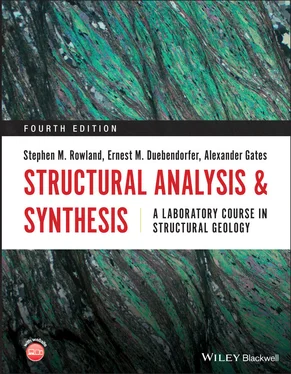1 Cover
2 Title Page Structural Analysis and Synthesis A Laboratory Course in Structural Geology Fourth Edition Stephen M. Rowland University of Nevada, Las Vegas United States Ernest M. Duebendorfer Northern Arizona University Arizona United States Alexander Gates Rutgers University, Newark New Jersey United States
3 Copyright Page
4 Preface
5 About the Companion Website
6 1 Attitudes of Lines and Planes Definitions Structural Elements Structural Grain
7 2 Outcrop Patterns and Structure Contours Structure Contours The Three‐Point Problem Drawing a Topographic Profile Drawing Cross Sections of Structure Contour Maps Determining Outcrop Patterns with Structure Contours Gently Bent Layers Determining Exact Attitudes from Outcrop Patterns Determining Stratigraphic Thickness in Flat Terrain Determining Stratigraphic Thickness on Slopes Determining Stratigraphic Thickness by Orthographic Projection
8 3 Stereographic Projection Plotting a Plane Plotting a Line Plotting the Pole to a Plane Line of Intersection of Two Planes Angles of Lines within a Plane Determining True Dip from Strike and Apparent Dip Determining Strike and Dip from Two Apparent Dips
9 4 Folds and Cross Sections Glossary of Fold Terms Classification by Shape Classification by Orientation Fold Classification Based on Dip Isogons Outcrop Patterns of Folds Cross or Structure Sections of Folded Layers The Arc Method Down‐Plunge Projection
10 5 Stereographic Analysis of Folded Rocks Beta (β) Diagrams Pi (π) Diagrams Pole Plotter Determining the Orientation of the Axial Plane Using Fold Trace Constructing the Profile of a Fold Exposed in Flat Terrain Determining the Orientation of the Axial Plane Without a Fold Trace Simple Equal‐Area Diagrams of Fold Orientation Contour Diagrams Determining the Fold Style and Interlimb Angle from Contoured Pi Diagrams
11 6 Rotations and Determining Original Directions in Folded Rocks Rotation of Lines The Two‐Tilt Problem Cones: The Drill‐Hole Problem Unfolding Folds
12 7 Foliations, Parasitic Folds,and Superposed Folds Foliations Axial Planar, Fanning, and Transecting Foliations Bedding/Cleavage Relations in Folds Parasitic Folds Multiple Deformations Multiple Foliations Superposed Folds
13 8 Strain Measurements in Ductile Rocks Longitudinal Strain Shear Strain The Strain Ellipse Strain Fields The Coaxial Total Strain Ellipse Measuring Strain in Deformed Objects Strain in Folds Deformed Fossils as Strain Indicators Mohr Circle for Sheared Fossils Mohr Circle for Boudinage
14 9 Advanced Strain Measurements Fry Method Rf/φ Method
15 10 Brittle Failure Quantifying Two‐Dimensional Stress The Mohr Diagram The Mohr Circle of Stress Rules for Going Between Mohr Space and Real Space The Failure Envelope The Importance of Pore Pressure
16 11 Analysis of Fracture Systems Data Collection Rose Diagram Length vs Strike Graphs Interpreting Joint Strike Diagrams Contouring Joint Density Accounting for Dip in Joints
17 12 Faults Measuring Slip Rotational (Scissor) Faulting Map Patterns of Faults Timing of Faults
18 13 Dynamic and Kinematic Analysis of Faults Dynamic Analysis Kinematic Analysis
19 14 Structural Synthesis Structural Synthesis Some Suggestions for Writing Style Common Errors in Geologic Reports
20 15 Deformation Mechanisms in Mylonites Deformation Mechanisms Fault Rocks Kinematic Indicators S‐C Fabrics Asymmetric Porphyroclasts Oblique Grain Shapes in Recrystallized Quartz Aggregates Antithetic Shears Strain and Offset in Shear Zones Potential Sources of Error Note
21 16 Construction of Balanced Cross Sections Thrust‐Belt “Rules” Recognizing Ramps and Flats Relations Between Folds and Thrusts Requirements of a Balanced Cross Section Constructing a Restored Cross Section Constructing a Balanced Cross Section
22 17 Introduction to Plate Tectonics Fundamental Principles Plate Boundaries Triple Junctions Focal‐Mechanism Solutions (“Beach‐Ball” Diagrams) Earth Magnetism Apparent Polar Wander
23 18 Virtual Field Trip Newfoundland Folds Field Trip Ramapo Fault Field Trip
24 References
25 Further ReadingChapter 1: Attitudes of Lines and Planes Chapter 2: Outcrop Patterns and Structure Contours Chapter 3: Stereographic Projection Chapter 4: Folds and Cross Sections Chapter 5: Stereographic Analysis of Folded Rocks Chapter 6: Rotations and Determining Original Directions in Folded Rocks Chapter 7: Foliations, Parasitic Folds, and Superposed Folds Chapter 8: Strain Measurements in Ductile Rocks Chapter 9: Advanced Strain Measurements Chapter 10: Brittle Failure Chapter 11: Analysis of Fracture Systems Chapter 12: Faults Chapter 13: Dynamic and Kinematic Analysis of Faults Chapter 14: Structural Synthesis Chapter 15: Deformation Mechanisms in Mylonites Chapter 16: Construction of Balanced Cross Sections Chapter 17: Introduction to Plate Tectonics
26 Index
27 End User License Agreement
1 Chapter 1 Table 1.1 Common symbols used on geologic maps.
2 Chapter 10Table 10.1 Data from a rock fracture experiment. Mohr circles corresponding t...Table 10.2 Data from three fracture experiments on identical rock samples. Th...Table 10.3 Coulomb coefficient μ of nine rock units (Modified from Suppe 1985...
1 Chapter 1 Figure 1.1 Strike and dip of a plane. Figure 1.2 Trend and plunge of an apparent dip. Figure 1.3 Azimuth and quadrant methods of expressing compass directions. Figure 1.4 Pitch (or rake) of a line in an inclined plane. Figure 1.5 Measuring the strike or trend of a structural symbol using a prot... Figure 1.6 Topographic map showing linear ridges and the line to measure str... Figure P1.1 Base map on which to plot structural symbols in Problem 1.4. Figure P1.2 Map with structural symbols to be read back in Problem 1.5. Figure P1.3 Topographic map showing linear ridges with uneven slopes to meas...
2 Chapter 2 Figure 2.1 Horizontal layer in a stream valley. (a) Block diagram. (b) Map v... Figure 2.2 Vertical layer strikes perpendicular across a ridge and valley. (... Figure 2.3 Inclined layer strikes perpendicular across a horizontal ridge. (... Figure 2.4 Inclined layer dipping upstream that flows 90° to strike. (a) Blo... Figure 2.5 Layer dipping parallel to stream gradient (perpendicular strike).... Figure 2.6 Layer dipping downstream more gently than the stream gradient wit... Figure 2.7 Layer dipping downstream more steeply than the stream gradient; s... Figure 2.8 Example of structure contours on a structural surface. Figure 2.9 Block diagram (a) and structure‐contour map (b) of a subsurface f... Figure 2.10 Solution of a three‐point problem using a combination of graphic... Figure 2.11 Technique for drawing a topographic profile. (a) Draw section li... Figure 2.12 Technique for drawing a cross section. The top diagram is a map ... Figure 2.13 Determination of outcrop pattern using structure contours. (a) T... Figure 2.14 (a) Structure‐contour map from Figure 2.13 shifted such that the... Figure 2.15 Determination of outcrop pattern of a gently bent surface using ... Figure 2.16 Technique for determining the orientation of a plane from its ou... Figure 2.17 Neogene units in the Bree Creek area. Tg = Conglomerate; Thd = S... Figure 2.18 Trigonometric relationships used for determining stratigraphic t... Figure 2.19 Determining stratigraphic thickness t on slopes. (a) Lengths h a... Figure 2.20 Three combinations of sloping topography and dipping layers, wit... Figure 2.21 Technique for determining stratigraphic thickness by orthographi... Figure P2.1 Map of an area showing contacts and topographic contours to be u... Figure P2.2 Cutout to produce a block model of the area in Figure P2.1 to vi... Figure P2.3 Base map showing locations of wells to be used in Problem 2.2. Figure P2.4 Topographic contour map to be used in Problem 2.3 showing locati... Figure P2.5 Topographic base map with outcrop locations to be used in the so...
Читать дальше











